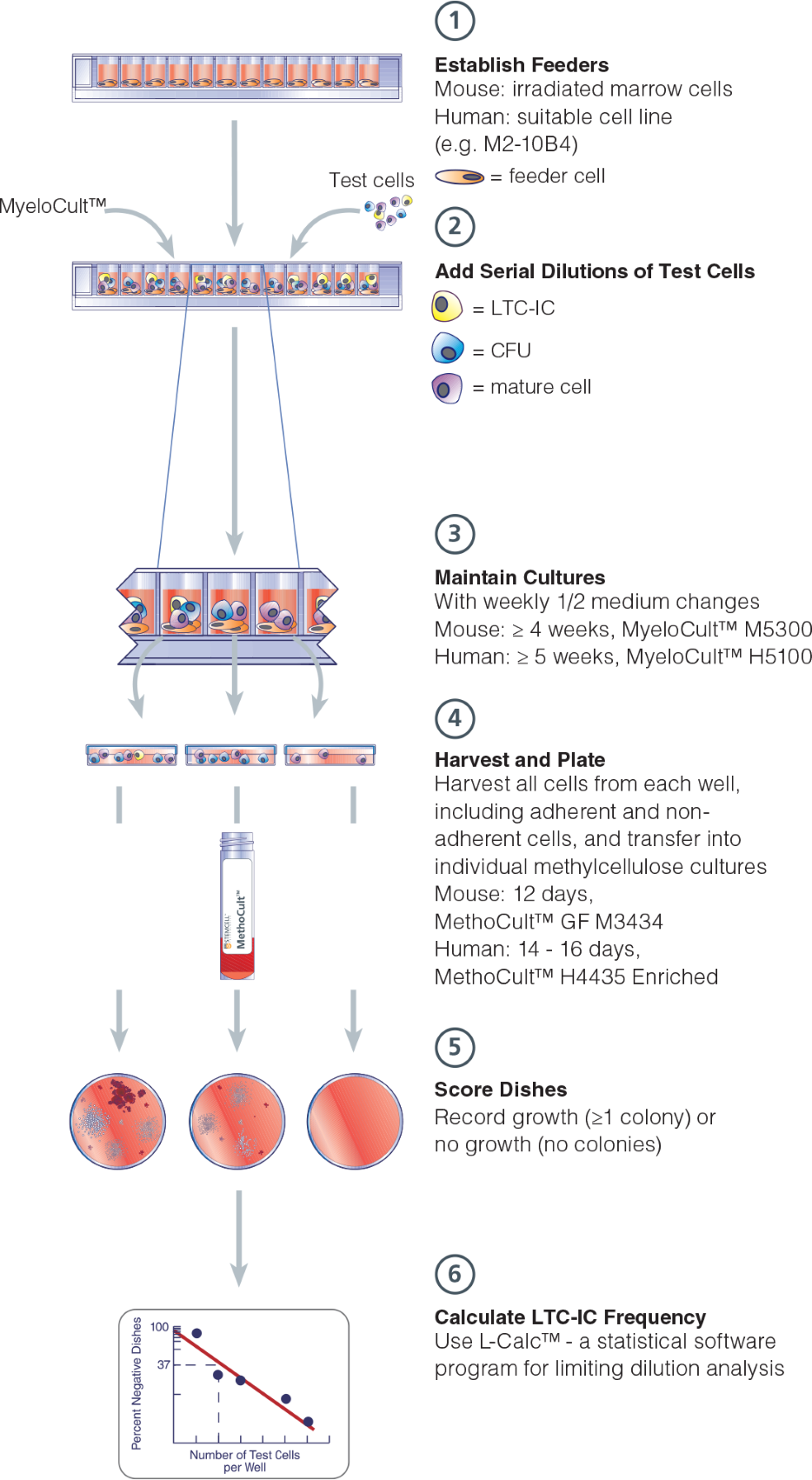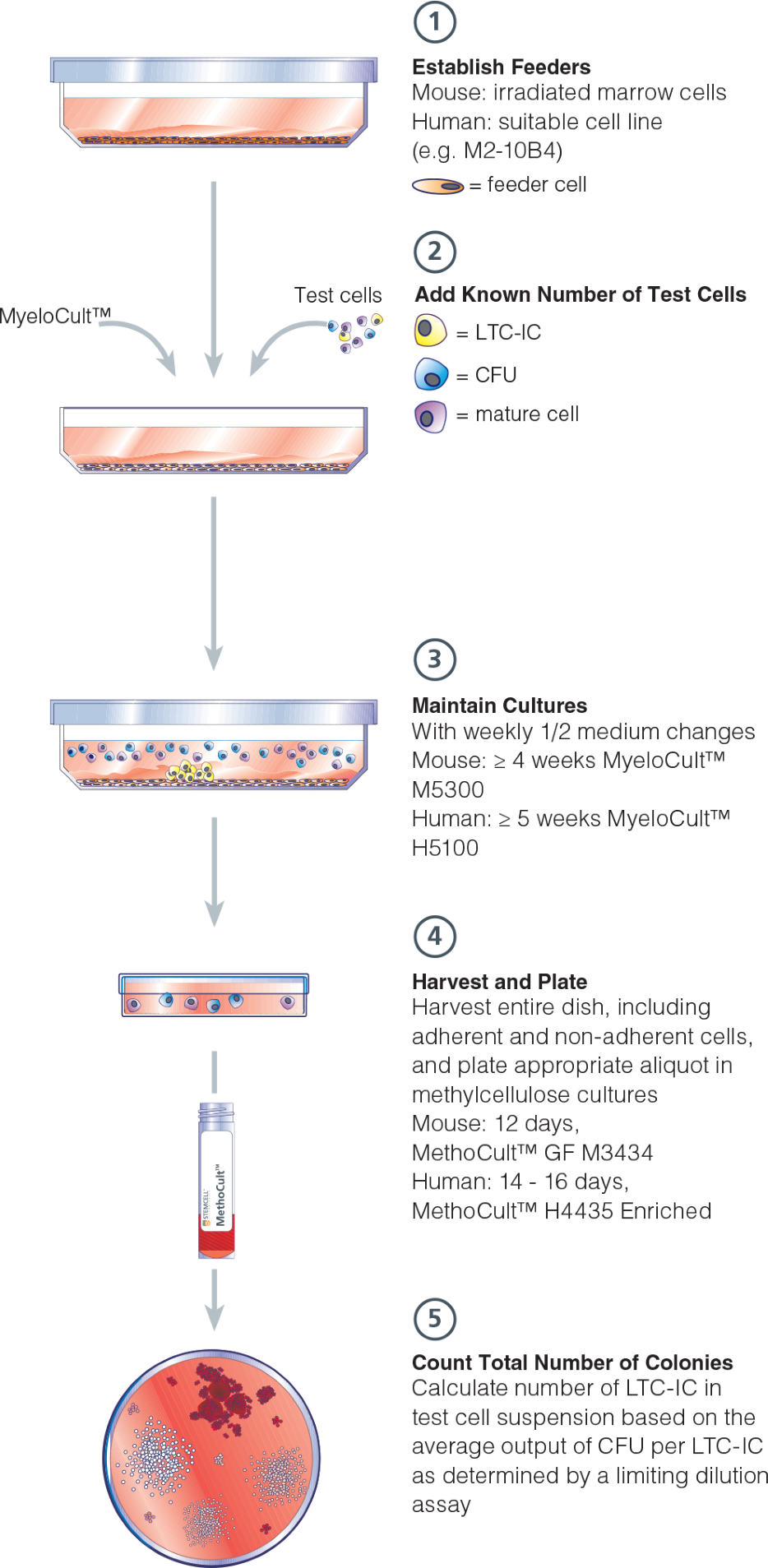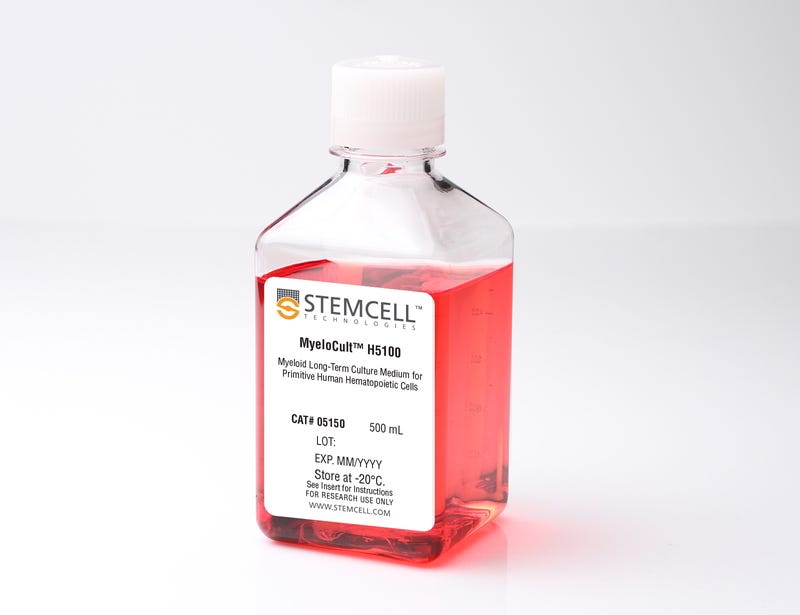MyeloCult™ - Long-Term Culture-Initiating Cell (LTC-IC) Assays
MyeloCult™ Media for LTC-IC Assays
Long-Term Culture of Human and Mouse Hematopoietic Progenitor Cells
MyeloCult™ media have been developed for the long-term culture of hematopoietic progenitor cells in association with adherent stromal cells. An important application of MyeloCult™ is the quantitation of primitive hematopoietic progenitor cells in the
long-term culture-initiating cell (LTC-IC) assay
. In this assay hematopoietic cells are cultured in MyeloCult™ medium with supportive human or mouse stromal cell layers and tested for their ability to generate myeloid clonogenic progenitors for several weeks as assayed by replating the cells in a
colony-forming unit (CFU) assay
using
medium.
Why Use MyeloCult™?
- Establish stromal cell layers and culture hematopoietic progenitors in “Dexter-type” long-term bone marrow cultures.1,2
- Perform LTC-IC assays in MyeloCult™ media.3
- Study regulators of myelopoiesis in long-term cultures.3
Protocol

Figure 1. Procedure for Limiting-Dilution Long Term Culture-Initiating Cell (LTC-IC) Assay

Figure 2. Procedure for Bulk Culture LTC-IC Assay
Key Applications
Human Hematopoietic Cell Culture
Nemeth M et al. (2009) beta-Catenin expression in the bone marrow microenvironment is required for long-term maintenance of primitive hematopoietic cells. Stem Cells 27(5): 1109-1119
Tipping A et al. (2009) High GATA-2 expression inhibits human hematopoietic stem and progenitor cell function via effects on cell cycle. Blood
Peterson M et al. (2008) Inhibitory receptor signaling via tyrosine phosphorylation of the adaptor Crk. Immunity 29(4): 578-588
Carlo-Stella C et al. (2007) Placental growth factor-1 potentiates hematopoietic progenitor cell mobilization induced by granulocyte colony-stimulating factor in mice and nonhuman primates. Stem Cells 25(1): 252-261
Pastos K et al. (2006) Differential effects of recombinant thrombopoietin and bone marrow stromal-conditioned media on neonatal versus adult megakaryocytes. Blood 108(10): 3360-3362
Sloand E et al. (2006) Granulocyte colony-stimulating factor preferentially stimulates proliferation of monosomy 7 cells bearing the isoform IV receptor. Proc Natl Acad Sci 103(39): 14483-14488
Pirson L et al. (2006) Despite inhibition of hematopoietic progenitor cell growth in vitro, the tyrosine kinase inhibitor imatinib does not impair engraftment of human CD133+ cells into NOD/SCIDbeta2mNull mice. Stem Cells 24(7): 1814-1821
Takeda A et al. (2006) NUP98-HOXA9 induces long-term proliferation and blocks differentiation of primary human CD34+ hematopoietic cells. Cancer Res 66(13): 6628-6637
Giebel B et al. (2006) Primitive human hematopoietic cells give rise to differentially specified daughter cells upon their initial cell division. Blood 107(5): 2146-2152
Srour E et al. (2005) Modulation of in vitro proliferation kinetics and primitive hematopoietic potential of individual human CD34+CD38-/lo cells in G0. Blood 105(8): 3109-3116
Selleri C et al. (2005) Involvement of the urokinase-type plasminogen activator receptor in hematopoietic stem cell mobilization. Blood 105(5): 2198-2205
Giebel B et al. (2004) Segregation of lipid raft markers including CD133 in polarized human hematopoietic stem and progenitor cells. Blood 104(8): 2332-2338
Kogler G et al. (2004) A new human somatic stem cell from placental cord blood with intrinsic pluripotent differentiation potential. J of Exp Med 200(2): 123-135
Guan Y et al. (2003) Detection, isolation, and stimulation of quiescent primitive leukemic progenitor cells from patients with acute myeloid leukemia (AML). Blood 101(8): 3142-3149
Bartolovic K et al. (2004) Inhibitory effect of imatinib on normal progenitor cells in vitro. Blood 103(2): 523-529
Stier S et al. (2003) Ex vivo targeting of p21Cip1/Waf1 permits relative expansion of human hematopoietic stem cells. Blood 102(4): 1260-1266
Danet G et al. (2003) Expansion of human SCID-repopulating cells under hypoxic conditions. J of Clin Invest 112(1): 126-135
Dybedal I et al. (2003) Human reconstituting hematopoietic stem cells up-regulate Fas expression upon active cell cycling but remain resistant to Fas-induced suppression. Blood 102(1): 118-126
Punzel M et al. (2003) The symmetry of initial divisions of human hematopoietic progenitors is altered only by the cellular microenvironment. Exp Hematol 31(4): 339-347
Murdoch B et al. (2003) Wnt-5A augments repopulating capacity and primitive hematopoietic development of human blood stem cells in vivo. Proc Natl Acad Sci 100(6): 3422-3427
Kootstra N et al. (2003) Abrogation of postentry restriction of HIV-1-based lentiviral vector transduction in simian cells. Proc Natl Acad Sci U S A 100(3): 1298-1303
Bhatia M et al. (1998) A newly discovered class of human hematopoietic cells with SCID-repopulating activity. Nat Med 4(9): 1038-1045
Dybedal I et al. (2003) Human reconstituting hematopoietic stem cells up-regulate Fas expression upon active cell cycling but remain resistant to Fas-induced suppression. Blood 102(1): 118-126
Tipping A et al. (2009) High GATA-2 expression inhibits human hematopoietic stem and progenitor cell function via effects on cell cycle. Blood
Peterson M et al. (2008) Inhibitory receptor signaling via tyrosine phosphorylation of the adaptor Crk. Immunity 29(4): 578-588
Carlo-Stella C et al. (2007) Placental growth factor-1 potentiates hematopoietic progenitor cell mobilization induced by granulocyte colony-stimulating factor in mice and nonhuman primates. Stem Cells 25(1): 252-261
Pastos K et al. (2006) Differential effects of recombinant thrombopoietin and bone marrow stromal-conditioned media on neonatal versus adult megakaryocytes. Blood 108(10): 3360-3362
Sloand E et al. (2006) Granulocyte colony-stimulating factor preferentially stimulates proliferation of monosomy 7 cells bearing the isoform IV receptor. Proc Natl Acad Sci 103(39): 14483-14488
Pirson L et al. (2006) Despite inhibition of hematopoietic progenitor cell growth in vitro, the tyrosine kinase inhibitor imatinib does not impair engraftment of human CD133+ cells into NOD/SCIDbeta2mNull mice. Stem Cells 24(7): 1814-1821
Takeda A et al. (2006) NUP98-HOXA9 induces long-term proliferation and blocks differentiation of primary human CD34+ hematopoietic cells. Cancer Res 66(13): 6628-6637
Giebel B et al. (2006) Primitive human hematopoietic cells give rise to differentially specified daughter cells upon their initial cell division. Blood 107(5): 2146-2152
Srour E et al. (2005) Modulation of in vitro proliferation kinetics and primitive hematopoietic potential of individual human CD34+CD38-/lo cells in G0. Blood 105(8): 3109-3116
Selleri C et al. (2005) Involvement of the urokinase-type plasminogen activator receptor in hematopoietic stem cell mobilization. Blood 105(5): 2198-2205
Giebel B et al. (2004) Segregation of lipid raft markers including CD133 in polarized human hematopoietic stem and progenitor cells. Blood 104(8): 2332-2338
Kogler G et al. (2004) A new human somatic stem cell from placental cord blood with intrinsic pluripotent differentiation potential. J of Exp Med 200(2): 123-135
Guan Y et al. (2003) Detection, isolation, and stimulation of quiescent primitive leukemic progenitor cells from patients with acute myeloid leukemia (AML). Blood 101(8): 3142-3149
Bartolovic K et al. (2004) Inhibitory effect of imatinib on normal progenitor cells in vitro. Blood 103(2): 523-529
Stier S et al. (2003) Ex vivo targeting of p21Cip1/Waf1 permits relative expansion of human hematopoietic stem cells. Blood 102(4): 1260-1266
Danet G et al. (2003) Expansion of human SCID-repopulating cells under hypoxic conditions. J of Clin Invest 112(1): 126-135
Dybedal I et al. (2003) Human reconstituting hematopoietic stem cells up-regulate Fas expression upon active cell cycling but remain resistant to Fas-induced suppression. Blood 102(1): 118-126
Punzel M et al. (2003) The symmetry of initial divisions of human hematopoietic progenitors is altered only by the cellular microenvironment. Exp Hematol 31(4): 339-347
Murdoch B et al. (2003) Wnt-5A augments repopulating capacity and primitive hematopoietic development of human blood stem cells in vivo. Proc Natl Acad Sci 100(6): 3422-3427
Kootstra N et al. (2003) Abrogation of postentry restriction of HIV-1-based lentiviral vector transduction in simian cells. Proc Natl Acad Sci U S A 100(3): 1298-1303
Bhatia M et al. (1998) A newly discovered class of human hematopoietic cells with SCID-repopulating activity. Nat Med 4(9): 1038-1045
Dybedal I et al. (2003) Human reconstituting hematopoietic stem cells up-regulate Fas expression upon active cell cycling but remain resistant to Fas-induced suppression. Blood 102(1): 118-126
Mouse Hematopoietic Cell Culture
Zimmer S et al. (2011) Crebbp haploinsufficiency in mice alters the bone marrow microenvironment leading to loss of stem cells and excessive myelopoiesis. Blood
Lymperi S et al. (2010) Inhibition of osteoclast function reduces hematopoietic stem cell numbers in vivo. Blood 117(5): 1540-1549
Ohno Y et al. (2010) Hoxb4 transduction down-regulates Geminin protein, providing hematopoietic stem and progenitor cells with proliferation potential. Proc Natl Acad Sci
Ohmori T et al. (2010) Vinculin is indispensable for repopulation by hematopoietic stem cells, independent of integrin function.J Biol Chem 285(41): 31763-31773
Zhang Q et al. (2010) Fancd2-/- mice have hematopoietic defects that can be partially corrected by resveratrol. Blood
Sumitomo A et al. (2010) Transcriptional Mediator Subunit MED1/TRAP220 in Stromal Cells Is Involved in Hematopoietic Stem/Progenitor Cell Support through Osteopontin Expression. Mol Cell Biol
Pandit T et al. (2006) Sustained exposure to nicotine leads to extramedullary hematopoiesis in the spleen.Stem cells 24(11): 2373-2381
Lee Y et al. (2006) CCAAT/enhancer binding proteins alpha and epsilon cooperate with all-trans retinoic acid in therapy but differ in their antileukemic activities. Blood 108(7): 2416-2419
Carella C et al. (2006) The ETS factor TEL2 is a hematopoietic oncoprotein. Blood 107(3): 1124-1132
Carmen M et al. (2004) Interleukin-6 deficiency affects bone marrow stromal precursors, resulting in defective hematopoietic support.Blood 103(9): 3349-3354
Lacout C et al. (2003) A defect in hematopoietic stem cell migration explains the nonrandom X-chromosome inactivation in carriers of Wiskott-Aldrich syndrome. Blood 102(4): 1282-1289
Truong B et al. (2003) CCAAT/Enhancer binding proteins repress the leukemic phenotype of acute myeloid leukemia. Blood 101(3): 1141-1148
Jin H et al. (2002) Intracerebral transplantation of mesenchymal stem cells into acid sphingomyelinase-deficient mice delays the onset of neurological abnormalities and extends their life span. J of Clin Invest 109(9): 1183-1191
Samper E et al. (2002) Long-term repopulating ability of telomerase-deficient murine hematopoietic stem cells.Blood 99(8): 2767-2775
Iversen P et al. (2002) Decreased hematopoiesis in bone marrow of mice with congestive heart failure. Am J of Physiol, Regul, Integr Comp Physiol 282(1): R166-72
Jasinski M et al. (2001) GATA1-Cre mediates Piga gene inactivation in the erythroid/megakaryocytic lineage and leads to circulating red cells with a partial deficiency in glycosyl phosphatidylinositol-linked proteins (paroxysmal nocturnal hemoglobinuria type II cells). Blood 98(7): 2248-2255
Lymperi S et al. (2010) Inhibition of osteoclast function reduces hematopoietic stem cell numbers in vivo. Blood 117(5): 1540-1549
Ohno Y et al. (2010) Hoxb4 transduction down-regulates Geminin protein, providing hematopoietic stem and progenitor cells with proliferation potential. Proc Natl Acad Sci
Ohmori T et al. (2010) Vinculin is indispensable for repopulation by hematopoietic stem cells, independent of integrin function.J Biol Chem 285(41): 31763-31773
Zhang Q et al. (2010) Fancd2-/- mice have hematopoietic defects that can be partially corrected by resveratrol. Blood
Sumitomo A et al. (2010) Transcriptional Mediator Subunit MED1/TRAP220 in Stromal Cells Is Involved in Hematopoietic Stem/Progenitor Cell Support through Osteopontin Expression. Mol Cell Biol
Pandit T et al. (2006) Sustained exposure to nicotine leads to extramedullary hematopoiesis in the spleen.Stem cells 24(11): 2373-2381
Lee Y et al. (2006) CCAAT/enhancer binding proteins alpha and epsilon cooperate with all-trans retinoic acid in therapy but differ in their antileukemic activities. Blood 108(7): 2416-2419
Carella C et al. (2006) The ETS factor TEL2 is a hematopoietic oncoprotein. Blood 107(3): 1124-1132
Carmen M et al. (2004) Interleukin-6 deficiency affects bone marrow stromal precursors, resulting in defective hematopoietic support.Blood 103(9): 3349-3354
Lacout C et al. (2003) A defect in hematopoietic stem cell migration explains the nonrandom X-chromosome inactivation in carriers of Wiskott-Aldrich syndrome. Blood 102(4): 1282-1289
Truong B et al. (2003) CCAAT/Enhancer binding proteins repress the leukemic phenotype of acute myeloid leukemia. Blood 101(3): 1141-1148
Jin H et al. (2002) Intracerebral transplantation of mesenchymal stem cells into acid sphingomyelinase-deficient mice delays the onset of neurological abnormalities and extends their life span. J of Clin Invest 109(9): 1183-1191
Samper E et al. (2002) Long-term repopulating ability of telomerase-deficient murine hematopoietic stem cells.Blood 99(8): 2767-2775
Iversen P et al. (2002) Decreased hematopoiesis in bone marrow of mice with congestive heart failure. Am J of Physiol, Regul, Integr Comp Physiol 282(1): R166-72
Jasinski M et al. (2001) GATA1-Cre mediates Piga gene inactivation in the erythroid/megakaryocytic lineage and leads to circulating red cells with a partial deficiency in glycosyl phosphatidylinositol-linked proteins (paroxysmal nocturnal hemoglobinuria type II cells). Blood 98(7): 2248-2255
Other Uses
Human NK Cell Culture
Keskin D et al. (2007) TGFbeta promotes conversion of CD16+ peripheral blood NK cells into CD16- NK cells with similarities to decidual NK cells.Proc Natl Acad Sci 104(9): 3378-3383
Chen X et al. (2006) CD28-stimulated ERK2 phosphorylation is required for polarization of the microtubule organizing center and granules in YTS NK cells.Proc Natl Acad Sci 103(27): 10346-10351
Vieillard V et al. (2005) NK cytotoxicity against CD4+ T cells during HIV-1 infection: a gp41 peptide induces the expression of an NKp44 ligand.Proc Natl Acad Sci 102(31): 10981-10986
Baumann B et al. (2004) Lack of galactose-alpha-1,3-galactose expression on porcine endothelial cells prevents complement-induced lysis but not direct xenogeneic NK cytotoxicity. J Immunol 172(10): 6460-6467
Perez S et al. (2003) A novel myeloid-like NK cell progenitor in human umbilical cord blood.Blood 101(9): 3444-3450
Chen X et al. (2006) CD28-stimulated ERK2 phosphorylation is required for polarization of the microtubule organizing center and granules in YTS NK cells.Proc Natl Acad Sci 103(27): 10346-10351
Vieillard V et al. (2005) NK cytotoxicity against CD4+ T cells during HIV-1 infection: a gp41 peptide induces the expression of an NKp44 ligand.Proc Natl Acad Sci 102(31): 10981-10986
Baumann B et al. (2004) Lack of galactose-alpha-1,3-galactose expression on porcine endothelial cells prevents complement-induced lysis but not direct xenogeneic NK cytotoxicity. J Immunol 172(10): 6460-6467
Perez S et al. (2003) A novel myeloid-like NK cell progenitor in human umbilical cord blood.Blood 101(9): 3444-3450
Human Mesenchymal Cell Culture
Chen X et al. (2006) Bioreactor expansion of human adult bone marrow-derived mesenchymal stem cells. Stem Cells 24(9): 2052-2059
Chagraoui J et al. (2003) Fetal liver stroma consists of cells in epithelial-to-mesenchymal transition. Blood 101(8): 2973-2982
Baksh D et al. (2003) Adult human bone marrow-derived mesenchymal progenitor cells are capable of adhesion-independent survival and expansion. Exp Hematol 31(8): 723-732
Chagraoui J et al. (2003) Fetal liver stroma consists of cells in epithelial-to-mesenchymal transition. Blood 101(8): 2973-2982
Baksh D et al. (2003) Adult human bone marrow-derived mesenchymal progenitor cells are capable of adhesion-independent survival and expansion. Exp Hematol 31(8): 723-732
References
- Dexter T et al. (1977) Conditions controlling the proliferation of haematopoietic stem cells in vitro. J Cell Physiol 91(3): 335–44
- Gartner S et al. (1980) Long-term culture of human bone marrow cells. Proc Natl Acad Sci 77(8): 4756–9
- Sutherland H et al. (1990) Functional characterization of individual human hematopoietic stem cells cultured at limiting dilution on supportive marrow stromal layers. Proc Natl Acad Sci 87(9): 3584–8


